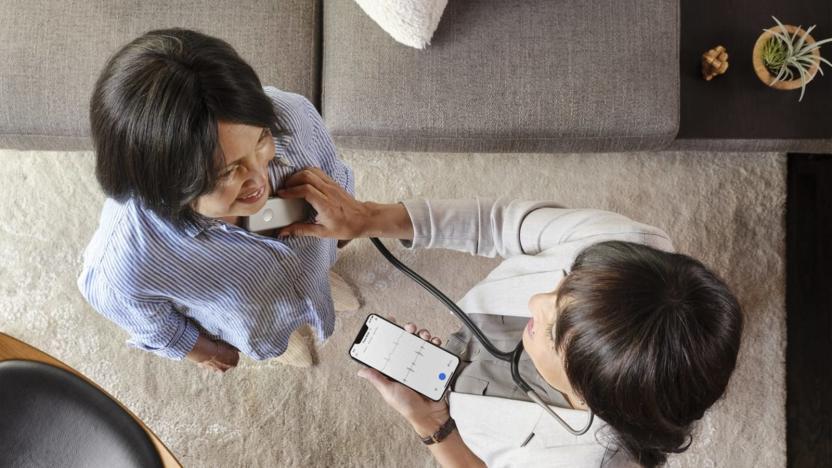MayoClinic
Latest

The FDA is fast-tracking an algorithm that screens for heart failure
Today, the FDA granted "breakthrough status" to an algorithm that could make screening for heart failure more accessible -- both in traditional clinics and telehealth settings. The algorithm uses a deep neural network developed by digital health company Eko and Mayo Clinic. With as little as 15 seconds of electrocardiogram (ECG) data, it can identify Left Ventricular Ejection Fraction (LVEF), a measure that's commonly used to diagnose patients with heart failure.

The Mayo Clinic created an online tool for predicting kidney stones
Researchers at the Mayo Clinic have created a handy tool for public use that can help determine if you'll have a recurring problem with kidney stones. The online calculator uses a number of factors about a person's lifestyle and health history to determine if they are at risk for the issue again after experiencing it once.

ICYMI: Health tech for VR sickness, smarter wifi and more
#fivemin-widget-blogsmith-image-1837{display:none;} .cke_show_borders #fivemin-widget-blogsmith-image-1837, #postcontentcontainer #fivemin-widget-blogsmith-image-1837{width:570px;display:block;} try{document.getElementById("fivemin-widget-blogsmith-image-1837").style.display="none";}catch(e){} Today on In Case You Missed It: The Mayo Clinic is licensing a new system that uses electrodes to fool the brain from getting sick when it doesn't detect movement while using a VR headset. New, open-source recycling machines will let makers transform plastics into whatever their hearts desire. And MIT designed a smarter wifi system that can tell who is inside a room and who is out, letting those in log on without needing a password. If you're into fire effects, check out Colin Furze's YouTube channel for a crazy DIY'd thermite launcher. As always, please share any great tech or science videos you find by using the #ICYMI hashtag on Twitter for @mskerryd.

Mayo Clinic might have the cure for VR motion sickness
Virtual reality systems are doing an awful lot to prevent nausea, but the fact still remains that some folks are going to get sick no matter how high the content's frame rate is or how low the latency. But Mayo Clinic might have a solution, Fast Company reports. The hospital has developed algorithms that, when paired with galvanic vestibular stimulation (GVS), can trick the brain into syncing what you're seeing in VR with physical stimulation within a tenth of a second.

Scientists extend the lifespan of mice by up to 35 percent
Would you like to live 35 percent longer? Apparently the trick is removing worn-out "senescent' cells that have a degenerative affect on your body. "Cellular senescence is a biological mechanism that functions as an 'emergency brake' used by damaged cells to stop dividing," says Jan van Deursen, Ph.D., Chair of Biochemistry and Molecular biology at Mayo Clinic, and senior author of the paper. Scientists added a suicide gene to genetically modified mice, giving them a drug that targeted senescent cells. Treated rodents lived between 25 and 35 percent longer, and were also healthier: they were more active, and had better functioning hearts and kidneys compared to the control group.

Researchers may have found a cancer cell's 'off' switch
Aside from their abnormal growth rates, cancerous cells aren't that much different from normal healthy tissue. That's why radiation and chemo treatments can't effectively target just tumors. However, a team of researchers from the Mayo Clinic believe they've discovered a mechanism that can rein in cancer's uninhibited growth by retraining these wayward cells to die like they're supposed to.

Violinist fiddles with a smart bow to help his brain surgery
It's common for brain surgery patients to stay awake. That's how surgeons know everything is going smoothly, after all. When concert violinist Roger Frisch started suffering from tremors that are only a problem when he's playing, however, Mayo Clinic doctors had to resort to some rather unusual technology to find out if they were installing the necessary brain pacemaker correctly. The surgical crew gave Frisch a bow equipped with a motion-tracking sensor and asked him to fiddle during the operation; the team knew it had electrodes in the right spot when the musician's performance was steady.

Switched On: The next steps for digital wellness, part two
Each week Ross Rubin contributes Switched On, a column about consumer technology. The last Switched On discussed many of the limitations of today's fitness monitors and how input regarding other lifestyle variations could create a more complete picture of how we control our health. But there are other health factors that change infrequently and can have a profound impact on our well-being.

iPad credited with helping save a man's life at the Mayo Clinic
The world-renowned Mayo Clinic in Rochester, Minnesota has been issuing iPads to physicians for a while, and now one of the Apple tablets is credited with helping to save the life of a man who suffered an arterial blockage at the facility. As reported in the Post-Bulletin newspaper, 48-year-old Andy McMonigle was working out with his cycling club at the clinic's Dan Abraham Healthy Living Center when he began to feel intense pressure in his arm. McMonigle has a history of heart trouble, so he immediately went to the locker room and asked a man for help. That man was Mayo Clinic internal medicine resident Dr. Daniel Leuders, who stayed by the side of McMonigle and yelled loudly for assistance. Two other Mayo residents (brothers Daniel and Christopher DeSimone) were literally just around the corner, so when they arrived Leuders reached into his backpack and pulled out his iPad. Within seconds, Leuders was connected to the Mayo's electronic medical record system, where he was able to pull up McMonigle's medical history. The history showed that McMonigle had a heart stent installed after a previous heart attack four years ago, which made the physicians suspect that he was suffering from a blockage in the stent. When an ambulance crew arrived, Leuders and the other physicians held the iPad record of McMonigle's previous EKG alongside the strip chart that was being printed in real time. What they saw further confirmed their suspicions about the blockage. The physicians made a choice based on the EKG records that probably saved McMonigle's life. Rather than wait upwards of three hours to run a blood test to verify the clotting, the doctors rushed McMonigle to the cardiac catheterization lab where a team (alerted by activating an emergency code) was waiting. They removed the clot from his artery, which was about 90 percent blocked. Within three days, McMonigle was released from the hospital and after four more days, he was working out again at the Healthy Living Center. Photo by D. Sharon Pruitt.

Mayo Clinic prescribes active games
The Wii has been getting a lot of attention lately, mainly because of its different control mechanism. However, movement in gaming isn't a new concept, which hearkens to days such as the NES Power Pad. Now, exergaming is getting a supporter. The Mayo Clinic has released a report on the results of an exergaming study. Using a sedentary base, games that use a camera (such as EyeToy) and using a treadmill while gaming burned triple the amount of calories as sitting (five times over for more obese children); dance games registered the greatest calorie burn at six times the sitting rate. With this new study, Nintendo is likely to jump on and further promote the health benefits of playing the Wii. Pulling children away from video games is a difficult task these days. While the Wii will unlikely burn the fat like Dance Dance Revolution would, they can add a bit to the marketing pamphlet to say the Wii requires exercise (if used right) for something their kid would otherwise be vegetating to do. As if we needed any more reasons to buy a Wii. [Thanks, Ben]

Shocking study reveals that activity in gaming fights obesity
Providing a mighty blow to both "research studies" and the value of Ph.D degrees everywhere, the latest rubbish information to come flowing from the Mayo Clinic's research lab is as close to an insult to intelligence as you can get. While it may have been somewhat understood that television can act as a painkiller for children, and that wireless headsets actually don't improve driving safety, this obviousness of this one takes the literal cake. The study, which is proclaimed as the "first to scientifically measure the energy spent playing video games," proved that sitting around while gaming burned the same amount of energy as kicking back and watching the tube, but when engaged in a "camera-based activity" (Eye Toy?), the "energy expenditure tripled." It was also shown that walking on a treadmill while gaming it up also tripled the energy burned, but it showed a "fivefold increase for the mildly obese group" of participants. While these results may be miles away from shocking, the most depressing aspect of the entire study was the conclusion that the results were so awe-inspiring that "they warrant further studies in randomized trials." Now, who's paying for this hoopla again?[Thanks, Mike]








